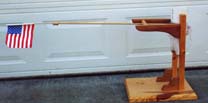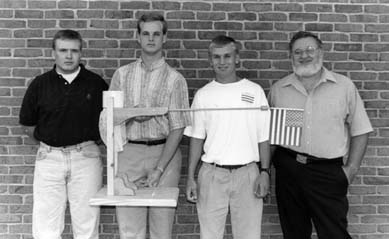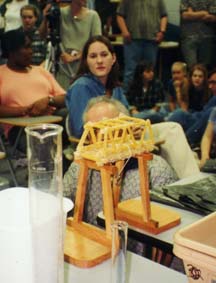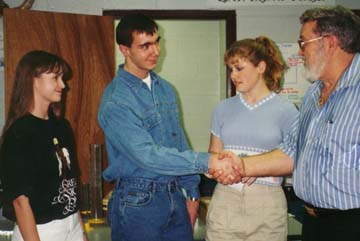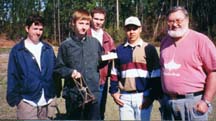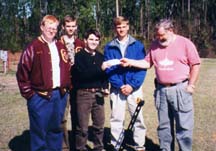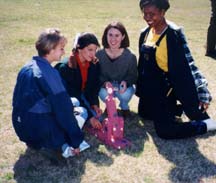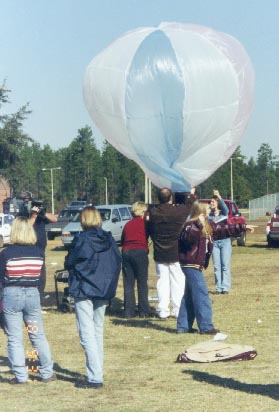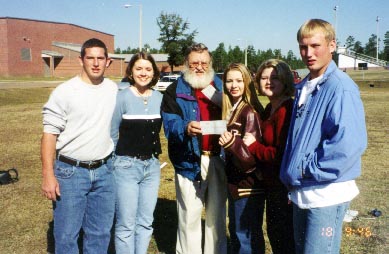Engineering Competition
One of my major interests is sponsoring a competition each year for the physics students at the local high school. Each year the problem is different and I hope teaches the students some important insights into the engineering process. In addition to teaching, I wish to reward those students that will take the harder science courses. A third objective is to have the local media publicize the student's academic accomplishments. The competition is open only to the members of the physic class.
First Engineering Competition
The objective of the 1996 competition was to raise the American flag. The only problem being that no student could get within 10 yards of the flag. As can be seen in the photo below, a basket was provided in the device to receive an egg that would tilt the flag. An egg was given to the students and they assumed that it was required to achieve the objective. However, nowhere in the rules was there a requirement to use the egg. A much simpler and faster method was available, simple use a string to flip the flag up. The students learned a very valuable lesson in the power of a paradigm. Winners of the competition with a score of 19 seconds were Paul Thompson, Eric Lee and Scott Purvis:
|
|
|
Second Engineering Competition
The objective of the second competition in 1997 was to build a bridge that would support the most weight, across the longest span and be as light as possible. The kicker in this competition was that the bridge could only be built of uncooked spaghetti and hot glue. The winning bridge, shown below, supported 53 pounds. Winners of the $150 first prize were Tara Davis, Della Maples and DeVan Hollman.
|
The winning bridge |
The winning team, Tara Davis, DeVan Hollman, Della Maples receiving the first prize. |
Third Engineering Competition
This year's competition was to build a catapult that will launch a raw egg. The principal of the school, Mr. Ronny Miller, graciously, if somewhat reluctantly, agreed to be the target of the competition. The students were judged on distance, accuracy, size and cost of their catapult. All teams produced outstanding entries that showed a great deal of thought in the design. The first place team had a maximum range of approximately 80 ft and edged out the second place team primarily on the basis of their low cost. All teams showed great competitive spirit and a lot of enthusiasm for egging the principal. The prizes for the competition were $150, $100 and $50. The competition took place on March 3, 1998 at the high school practice field and had excellent coverage by the local print and TV media.
The winners of the Third Engineering Competition are James Barbour, Owen Davis, Will Howell, and Jesse Hearndon.
|
|
|
|
|
|
Fourth Engineering Competition
The
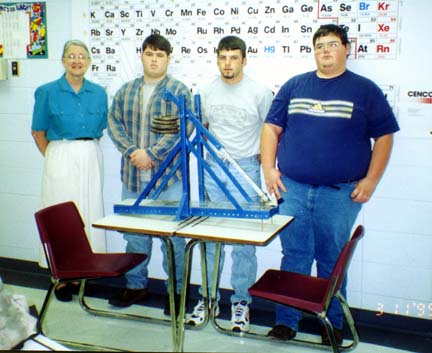
First place winners with their entry are shown above. Pictured are l-r, Mrs. McLeod, teacher, Adam Bradshaw, John Rouse, Micah Brannan. This trebuchet had tremendous accuracy with a standard deviation on only 4 inches. The range was about 60 feet.
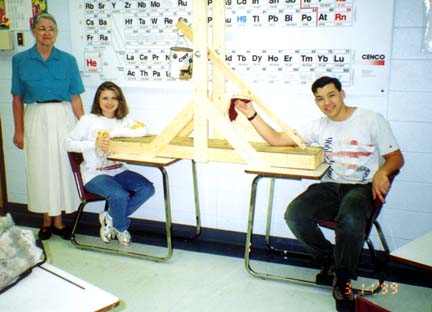
The second place entry is shown here with Mrs. McLeod, Vanessa Hodges and Anthony Randall. The performance of this Trebuchet was also good with a range of 65 feet.
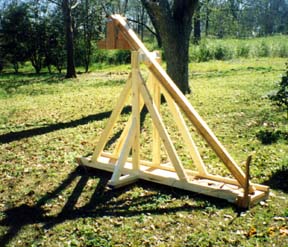
My treb, shown above, would throw a cantaloupe about 120 feet. However, it broke when attempting to throw an egg. Without the inertia of its normal load, the acceleration was too great and the weight basket was split by the 100-lb. weight.
Fifth Engineering Competition
The Fifth competition was held on November 19, 1999 and consisted of building a hot air balloon that would drop a raw egg on the school principal. Mr. Ronny Miller. The students were given information concerning lift and air temperature and had to design their balloon. They were judged on altitude and accuracy. Although all four teams constructed great balloons, the weather was not very cooperative and it was windy the day of the competition. Despite the handicaps, the winners were able to get their balloon aloft and on target. The winning team is shown below with their winning entry.
|
The winning balloon. |
The winners, l-r, Travis Jones, Tessa Ezell, myself, Monique Davis, Ashley Strahan, and Kevin Morgan |
Sixth Engineering Competition
The Sixth Competition consisted of building another trebuchet, similar to that in the fourth competition. However the rules were a bit different in that cost was not a factor, but size and weight were. We had 6 treb entries this year. As usual, the judging based upon a combination of distance, accuracy, size and weight produced some unusual results. The school principal, Ronny Miller, was again the target. I might add he came through frightened, but unscathed.
|
|
|
|
|
|
Seventh Engineering Competition
In the Seventh Competition, we tried to do something a bit different. I had heard of contests that dropped an egg from a height without breaking it. In this competition, the students were to through a raw egg with a catapult without breaking it. Several times, I had thrown an egg that did not break with out any protection, but my concept was that the students would package the egg. This would add weight and thus reduce distance. I did not figure on the ingenuity of the students. To encourage thinking outside of the box, the Rules state that anything not expressively prohibited is permitted. The girl’s team took full advantage of that rule and opted not to protect the egg at all. They stationed a student down range with a pillowcase between her arms and caught the egg in flight, unharmed. Way to go girls.
|
|
|
Eighth Engineering
Competition
The Eighth Engineering Competition was held on Dec. 12 2003. Unfortunately the physics class this year only had 3 students. The objective this year was to build a device to throw a projectile as far and as accurately as possible. The entries were judged on length of throw, weight of projectile and accuracy of the average of 3 throws. Normally the rules are written to minimize the size of the device so that the cost to the student is minimal. However, since this year’s class was so small and each entry would probably be rewarded, all size restrictions were removed. The students were told to build a machine that was as big and bad as they could. And they did. Although only two entries were produced, the students did an excellent job. Below are pictures of their effort.
|
Matt did an excellent job with his spring and weight powered catapult. His projectile was a shot-put, thrown for 96 feet and with an accuracy of about 2 feet |
Michael took second place with a mean 4-spring powered catapult. |
Ninth Engineering Competition
The Ninth Engineering Competition was held on April 21, 2005. The Physics Class has regained its numbers so that we went back to putting restrictions on the devices. Again this year we went with a catapult design for the competition and as usual, the students came through with innovating designs. The competition was judged on distance thrown of the egg, accuracy and weight of the device. These parameters help keep the size of the catapult down to manageable levels and are safer compared to the huge machines entered last year.
|
|
|
|
Tenth Engineering Competition
The Tenth Engineering Competition was
held on April 191, 2006 and again the objective was to build a catapult and to
attempt to hit the Physics teacher, Mr. Robert Smith with a raw egg. All of the catapults performed well and this
time the students had a design tool in the form of a computer program written
by my good friend, Gary Darby.
|
|
|
|
|
|
Eleventh Engineering Competition
This year’s competition was a little bit different in that the students were asked to construct a pneumatic egg cannon which fired a raw egg at the physics teacher, Mr. Robert Smith. The teams were judged on distance accuracy and weight of their cannons. Air pressure to the devices was limited to 60 psi for safety reasons, but most of the students reduced it further to keep the egg within the limits of visibility. All devices performed superbly with the winning edge going to the lightest cannon. The 3rd place winner threw finesse to the winds and built a monster. It won a bonus prize for “Most Awesome”. The runner up took a minimalist approach and moved the target to the 50 ft minimum distance required by the rules. Mr. Smith declined to be the target this close. After missing with 2 eggs, the runner up nailed the target to the cheers of all.
|
|
|
|
|
|
Rules for the above competitions may be obtained by e-mailing a request to James E.
Corley.
Main Page Watercolors Oil Paintings Wood Sculptures Wood Working Cartoons Interests
